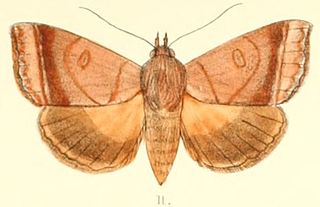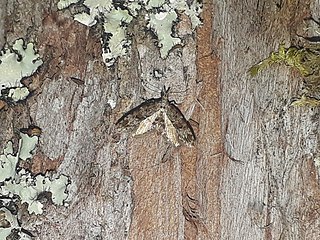
Cataclysta lemnata, the small china-mark, is a moth species of the family Crambidae. It is found in Europe, Morocco and Iran.

Nymphula nitidulata, the beautiful china-mark, is a species of moth of the family Crambidae described by Johann Siegfried Hufnagel in 1767. It is found in Europe, Japan (Hokkaido), Turkey, Armenia, Russia and China.

Agrotis vestigialis, the archer's dart, is a moth of the family Noctuidae. The species was first described by Johann Siegfried Hufnagel in 1766. It is found in most of the Palearctic realm from Ireland east, through to Russia, Siberia, the Altai mountains and the Amur region, and is also present in the Mediterranean Basin. It is absent from the north of Finland and Norway.

Ophiusa trapezium is a moth of the family Erebidae first described by Achille Guenée in 1852. It is found from the Indo-Australian tropics of India, Sri Lanka to Queensland, the Bismarck Islands and New Caledonia. Adults are fruit piercers.

Gypsonoma aceriana, the poplar shoot-borer, is a moth of the family Tortricidae. It is found from Europe to Russia, eastern Turkey and Iraq. It is also present in North Africa.

Athetis pallustris, the marsh moth, is a moth of the family Noctuidae. It is found in most of Europe, the southern Urals, southern Russia, Ukraine, eastern Turkey, Siberia, the Amur region, the Russian Far East, Mongolia and northern China.
Cyclotorna diplocentra is a moth of the family Cyclotornidae. It is found in Australia, including New South Wales and Queensland.

Nycteola revayana, the oak nycteoline, is a moth of the family Nolidae. The species was first described by Giovanni Antonio Scopoli in 1772. It is found from Europe and east across the Palearctic to Japan and India.

Isonomeutis restincta, the marbled snouter, is a species of moth in the family Copromorphidae. It is endemic to New Zealand where it is likely found in the northern parts of the North Island. Not much is known of the life history of this species but it has been hypothesised that it is a scale insect predator. The adults of this species are on the wing from November to January. This species has been classified as "At Risk, Naturally Uncommon" by the Department of Conservation.

Symmoca is a genus of moths in the family Autostichidae.

Agnippe laudatella is a moth of the family Gelechiidae. It is found in California, United States.
Symmoca orphnella is a moth of the family Autostichidae. It is found in France, Italy and Spain.
Symmoca petrogenes is a moth of the family Autostichidae. It is found in Spain.
Symmoca tofosella is a moth of the family Autostichidae. It is found in Portugal, Spain and Italy.
Symmoca uniformella is a moth of the family Autostichidae. It is found in Portugal and Spain.
Recurvaria thysanota is a moth of the family Gelechiidae. It is found in Mexico (Guerrero).
Symmoca alacris is a moth in the family Autostichidae. It was described by Edward Meyrick in 1918. It is found in Kanara in Karnataka, India.
Symmoca pelospora is a moth in the family Autostichidae. It was described by Edward Meyrick in 1927. It is found in Xinjiang, China.
Symmoca calidella is a moth in the family Autostichidae. It was described by Walsingham in 1905. It is found in Algeria.

Pammene argyrana is a species of moth belonging to the family Tortricidae.










